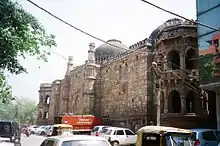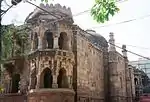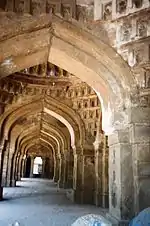Moth ki Masjid
Moth Ki Masjid (moʈʰ kiː masdʒɪd) is a heritage building located in Delhi, and was built in 1505 by Wazir Miya Bhoiya, Prime Minister during the reign of Sikander Lodi (1489–1517) of the Lodi dynasty. It was a new type of mosque developed by the Lodis in the fourth city of the medieval Delhi of the Delhi Sultanate.[1][2][3] The name of the mosque literally translated into English language means ‘Lentil Mosque’ and this name tag ‘Lentil’ has an interesting legend. This mosque was considered a beautiful Dome (Gumbad) structure of the period.[1]
| Moth ki Masjid | |
|---|---|
 Moth Ki Masjid | |
| Religion | |
| Affiliation | Islam |
| District | New Delhi |
| Province | Delhi |
| Ecclesiastical or organizational status | Mosque |
| Leadership | Lodi period |
| Year consecrated | 16th century |
| Location | |
| Location | |
| Country | India |
 Shown within Delhi  Moth ki Masjid (India) | |
| Territory | Delhi |
| Geographic coordinates | 28°33′45″N 77°13′4″E |
| Architecture | |
| Architect(s) | Miyan Bhuiya |
| Type | Mosque |
| Style | Medieval Indo Islamic architecture |
| Completed | 1505 |
| Specifications | |
| Length | 38.6 m (126.6 ft) |
| Dome(s) | Three (Semi circular) |
| Minaret(s) | None |
| Materials | Red Sandstone and Marble |
The mosque is now completely enclosed within the modern locality of South Extension Part II, Uday Park and Masjid Moth comprising residential and commercial establishments in the urban setting of South Delhi.[4]
It is surrounded by various other smaller dargahs and monuments that may be found peppered within the nooks of this urban village. The local representative in collaboration with residents is now trying to revive the monument.
Legend
It is famously narrated that when Sultan Sikandar Lodi was on a visit to a mosque in the vicinity of the present location of the Moth Ki Masjid for prayer, he knelt over a grain of moth (a kind of lentil), which had been dropped by a bird. His loyal Prime Minister Wazir Miya Bhoiya, who had accompanied the King, saw the lentil seed and observed that
A seed so honoured by His majesty must not be thrown away. It must be used in the service of God.
So he took the moth seed and planted it in his garden for further growth. Over the years, the process of repeated planting and replanting of the moth seeds was carried out. In this process, the seeds multiplied several times. The Wazir finally sold the rich harvest and earned good money. With the proceeds of the sale he built the mosque after seeking permission from the Sultan to construct the Mosque.[1] Impressed by the ingenuity of his minister, Sikandar Lodi laid the foundation for building the mosque.[5]
Another version of the legend is that Sikandar Lodhi on one of his visits to the area played a prank on his Prime Minister by giving him a gift of a grain of moth (lentil). The Wazir accepted the gift in good grace and instead of throwing it away planted it in his garden. Over the years repeated plantation resulted in a rich harvest that provided a surplus income to the Wazir. Thereafter, the wazir, with the revenue earned from the lentil grains, decided to build a mosque. On completion, he invited the Sultan to visit the mosque and narrated the sequence of events which led to the building of the mosque. Impressed by this unique achievement, the Lodi named the mosque as "Moth Ki Masjid" or the Mosque from the Moth Lentil.[6]
Structure

Raised on a high plinth, the mosque has a square layout. It is approached from the eastern side street of village Moti Masjid, through an exquisitely designed gate made of red, blue, black and white coloured sandstones arranged in a neat design (see picture). In particular, the arch of the gateway has a Hindu arch within a Muslim arch.[1][7]
Up the gateway steps, the entry is into a large courtyard of 38.6 m (126.6 ft) width surrounded by walls. Within the courtyard, on the western side is the main shrine or the mosque with the rectangular prayer hall porch, which has a façade of five arched openings. The corners of the rectangular prayer hall are adorned with double storied towers. The towers have arched openings at the rear end of the roof with domed octagonal chhatris (the Cenotophs) on the related walls. The west side wall is provided with tapering turrets that depict a sophisticated outline (pictured).
The Cenotophs were the first of its kind to be built in India and since then these have been replicated in several other monuments, even in the Deccan. There are three impressive domes inside the prayer hall with the Mihrab located on the west qibla wall of the central dome, which is the largest of the three domes. The Mihrab depicts Quranic inscriptions in flora Nakashi in Iranian design. Turrets project out of the qibla. The central dome is supported on squinches. The domes on both flanks are borne on muqarnas pendentives. Carved panels of red sandstone and white marble and plaster, as well as glazed tiles embellish the walls of the mosque. The overall effect of the Mosque has been best described as:
epitomizes in itself all that is best in Architecture of the Lodis and displays a freedom of imagination, a bold diversity of design, an appreciation of contrasting light and shade and a sense of harmony in line and colour, which combine to make it one of the most spirited and picturesque buildings of its kind in the whole range of Islamic art.[7][8][9]
It is also said that it was the private mosque of the builder.[5][10]

An unusual feature of this mosque built in Indo–Islamic style of architecture is that it has an austere design with no minarets, calligraphic decorations and embellishments, which are otherwise traditional features of mosques. The dome is semicircular and windows have latticework screens.[11] An architectural appreciation of the structure vis-à-vis the five arched façade of domes of the period aptly infers:[12]
the rapid crystallization of the earlier concept. Firstly, it is considerably larger than its predecessor. Secondly, the articulation of the recessed arches is far more adept. Thirdly, embellishment has been done using elegant niches on the columns abutting the arches. Another important feature is the use of better material and color, as if the masons were trying for something more permanent and forceful.
Visitor information
The monument is located in South Delhi and is well connected by road. Delhi International Airport is 21 km (13.0 mi) away. There are no visitor charges and is open on all days from sunrise to sun set.[7] There are several tourist attractions in the neighborhood of the Mosque, such as the Hauz Khas, Siri Fort, Kalkaji Temple, Lotus Temple, Nizamuddin Auliya and Chirag Dehlvi's Dargah.
Gallery
 Beautiful double storyed corner tower of the Masjid
Beautiful double storyed corner tower of the Masjid
References
| Wikimedia Commons has media related to Moth Ki Masjid. |
- Shiri Ram Bakshi (1995). Delhi Through Ages. The Moth-ki-Masjid. Anmol Publications Pvt. Ltd. pp. 70–71. ISBN 9788174881380.
- Geraldine Forbes; Gordon Johnson; B. R. Tomlinson; Stewart Gordon; Catherine Ella Blanshard Asher (1992). The new Cambridge history of India. Cambridge University Press. p. 10. ISBN 9780521267281. Retrieved 10 April 2009.
- Ahmad Nabi Khan (2003). Islamic architecture in South Asia: Pakistan, India, Bangladesh. Oxford University Press. p. 94. ISBN 9780195790658. Retrieved 26 April 2009.
Among them the most notable is the Moth Ki Masjid which was built by the Prime Minister of Sikanader Lodi in 1505
- "Indian temples". Retrieved 26 April 2009.
- "Dilli Ki Shaan :Moth Ki Masjid". Retrieved 26 April 2009.
- "Moth ki Masjid or Masjid Moth". Archived from the original on 22 May 2009. Retrieved 25 April 2009.
- "Moth-ki-Masjid". Retrieved 26 April 2009.
- M H Syed (2004). History of Delhi Sultanate. Anmol Publications Pvt. Ltd. p. 413. ISBN 9788126118304. Retrieved 26 April 2009.
- "Moth-ki Mosque". Arch Net Digital library. Archived from the original on 3 May 2012. Retrieved 26 April 2009.
- "Masjid Moth". Retrieved 25 April 2009.
- "Moth ki Masjid". Archived from the original on 21 February 2009. Retrieved 25 April 2009.CS1 maint: bot: original URL status unknown (link)
- "The End of the Delhi Sultanate – 2". Archived from the original on 16 May 2008. Retrieved 26 April 2009.

